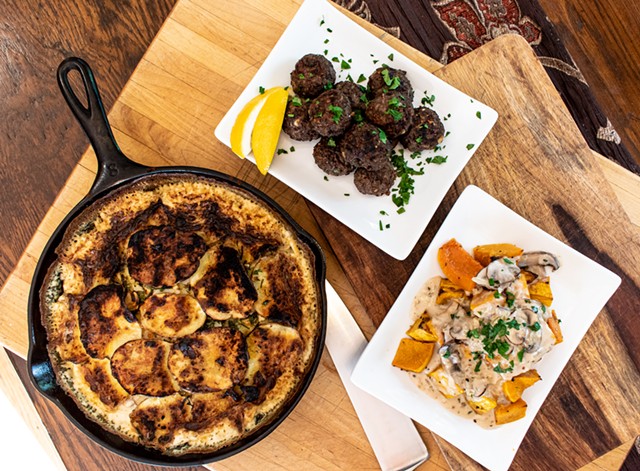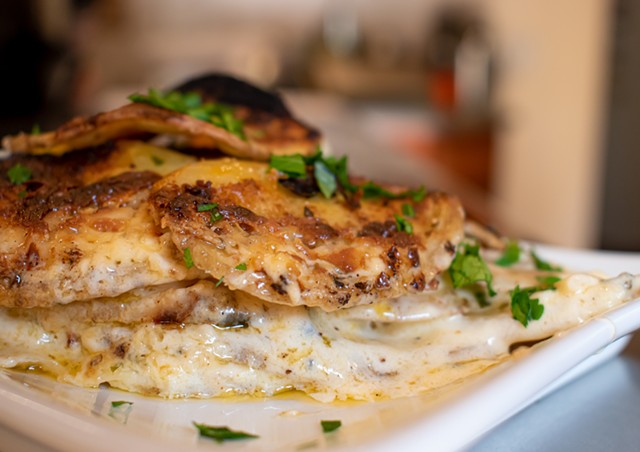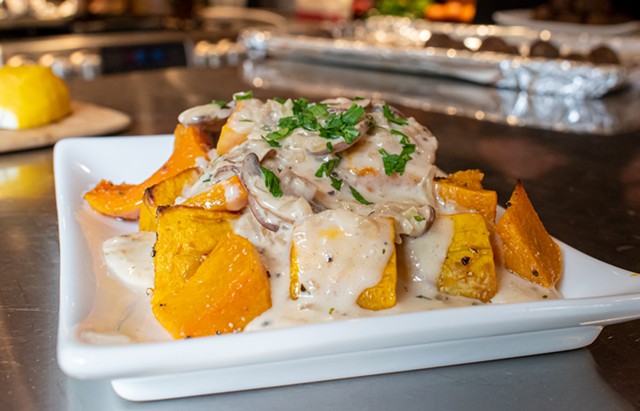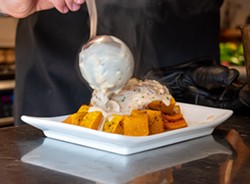
- PHOTO BY JACOB WALSH
Whatever your holiday plans this year — be it a small family gathering, potluck, meal exchange, or an elaborate Friendsgiving celebration — the need for an easy-yet-impressive side dish to accompany the main meal looms. That’s especially true if you’re gathering with others for Thanksgiving after a year of keeping your distance and want to wow them.
We’ve got you covered. The following three recipes are my personal riffs on some of the most familiar seasonal side dishes and feature exciting and bold flavors that will make your contribution to the holiday meal truly stand out.
Roasted potatoes with cream, garlic, and herbs
Serves 4-6

- PHOTO BY JACOB WALSH
You will need:
5-6 medium-sized Yukon potatoes (washed, skin on, sliced very thin)
4-6 cloves of hard neck garlic (peeled and roughly chopped)
1 tbsp of fresh parsley (roughly chopped)
1 tbsp of fresh rosemary (roughly chopped)
1 tsp of fresh thyme (removed from stem)
1 tsp of fresh chives (finely chopped)
Half a stick of unsalted butter (cut into small cubes)
1 cup of heavy cream
1 tsp of smoked paprika
Salt and pepper (to taste)
1. Preheat the oven to 375 degrees. Combine all the fresh herbs and chopped garlic in a bowl, mix well, set aside.
2. In a cast iron pan or oven-safe baking dish, layer the sliced potatoes followed by some of the herb-garlic mix, salt and pepper, and a splash of heavy cream. Repeat the process until all the ingredients have been used. It should ideally form five to seven layers total, but that may vary depending on thickness of potatoes and size of baking dish.

- PHOTO BY JACOB WALSH
4. Best served right after cooking, this dish will also hold up well to travel and being reheated. Once cooled to room temperature, cover the top of the pan or dish with a vented piece of foil. Once you’re ready to reheat and serve, preheat the oven to 350 degrees, remove foil cover, and heat until warmed throughout. If at all possible, avoid microwaving.
Moroccan mini-meatballs
Serves 4-6

- PHOTO BY JACOB WALSH
You will need
1 lb ground lamb
1 small red onion (finely diced)
2-3 cloves of hard neck garlic (peeled and finely chopped)
1 egg yolk
1/4 cup of fresh mint leaves (finely chopped)
1/4 cup of fresh parsely (finely chopped)
1/4 cup of fresh chives (finely chopped)
1 tbsp of ground cumin
1/2 tsp of Saigon cinnamon
1 tsp of Ras el Hanout spice blend (more to taste)
Olive oil
Salt and pepper (to taste)
1. Combine all ingredients and mix well by hand. Cover and refrigerate at least one hour (or overnight) to allow the flavors to marry. Once ready to cook, form the mixture into small meatballs and arrange on a large baking sheet. The meatballs should be about 1 inch in diameter.
2. Preheat the oven to 350 degrees. On the stove top, heat a frying pan on medium heat and warm enough olive oil to lightly coat the bottom of the pan. Fry the exterior of each meatball in batches as necessary until lightly golden brown on all sides, then transfer back to the original baking sheet.
3. Once all of the meatballs have been seared and transferred, bake on a center rack until cooked through, taking care not to overcook or dry out the meatballs. This should take roughly 15 minutes.
4. Best served right after cooking, this dish will also hold up well to travel and being reheated if necessary. Once cooled to room temperature, cover the top of the baking sheet or oven-safe serving dish with a vented piece of foil. Once you’re ready to reheat and serve, preheat the oven to 350 degrees, remove foil cover and heat until warmed throughout. If at all possible, avoid microwaving.
5. Serve with fresh cut lemon wedges as an optional garnish.
Roasted honeynut squash with cream and mushroom sauce
Serves 4-6

- PHOTO BY JACOB WALSH
Honeynut is denser, sweeter, and more versatile in flavor than its butternut cousin. It looks like a mini-version of the butternut and if you have yet to try this exciting fall squash, now is a good time to experiment.
You will need:
6-8 honeynut squashes (seeds and skin removed, cut into chunks)
3-4 cloves of hard neck garlic (peeled and finely chopped)
1 small yellow onion (very finely diced)
5-6 brown mushrooms (cleaned and sliced thin)
1 cup of half and half
1 tsp of all-purpose flour (more or less as needed)
1/4 of a stick of unsalted butter (cut into 4 pads)
1 tbsp of buckwheat honey
1 tbsp of fresh parsley (finely chopped for garnish)
Olive oil
Salt and pepper (to taste)
1. Preheat the oven to 375 degrees. In a large mixing bowl, toss the squash with a light amount of olive oil and a dusting of salt and pepper. Transfer the mixture to a baking pan or sheet that is large enough to accommodate a single layer of the squash mixture. Bake on a center rack until soft and golden brown, roughly 25 to 30 minutes.
2. Meanwhile, on the stovetop, heat a sauté pan on medium-high heat and add in the pads of butter with a splash of olive oil. Lightly cook the garlic and onion until very soft and lightly browned (5 to 10 minutes) then add in the mushrooms and cook until softened. Add the flour and quickly combine followed immediately by the half and half, a splash at a time while stirring. Once combined, stir in the buckwheat honey and reduce heat to low and allow the sauce to thicken slightly.

- PHOTO BY JACOB WALSH
4. This dish can also hold up to travel and being reheated if necessary if you keep the squash and sauce in separate containers and combine only after reheating each on its own, directly before serving. In this instance, a microwave is the simplest way of reheating.
J. Nevadomski is the author of the long-running "Highlife for Lowlifes" series and is a food and culture contributor to CITY. For more visit: highlifeforlowlifes.com, instagram.com/jnevadomski, and facebook.com/highlifeforlowlifes.
Feedback on this article can be directed to Rebecca Rafferty, CITY’s life editor, at [email protected].
